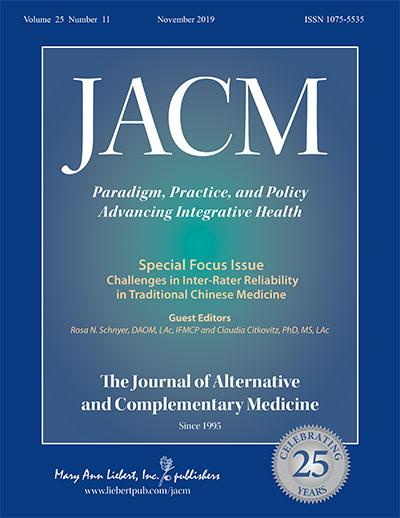
Credit: Mary Ann Liebert, Inc., publishers
New Rochelle, NY, November 20, 2019 — Diagnostic agreement between practitioners is an ongoing challenge in the evaluation of Traditional Chinese Medicine (TCM) and other healthcare systems that rely on constitutional types. The topic is the subject of a Special Focus Issue on Challenges in Inter-Rater Reliability in Traditional Chinese Medicine that is published as the November 2019 issue of JACM, The Journal of Alternative and Complementary Medicine, a peer-reviewed publication from Mary Ann Liebert, Inc., publishers, dedicated to paradigm, practice, and policy advancing integrative health. Click here to read the full Special Issue free on the JACM website through December 20, 2019.
The Special Issue was led by Guest Editors Rosa Schnyer, DAOM, LAc, IFMCP, Clinical Assistant Professor in the School of Nursing at the University of Texas and adjunct faculty at the Oregon College of Oriental Medicine and Bastyr University and Claudia Citkovitz, PhD, MS, LAc, Department of Rehabilitation Medicine, NYU Medical School, and Director of the Acupuncture Program at Lutheran Medical Center. The special issue includes an exploratory editorial from the Guest Editors, 4 invited commentaries, a systematic review, and 7 original articles.
In their editorial, “Inter-Rater Reliability in Traditional Chinese Medicine: Challenging Paradigmatic Assumptions,” Schnyer and Citkovitz note the issue’s timeliness. The WHO’s newly updated International Classification of Diseases (ICD-11) includes standardized terminology for Traditional Chinese Medicine (TCM) pattern diagnosis. This change reflects increasing prevalence of TCM’s use in the United States and other countries throughout the world and “stronger evidence of acupuncture’s effect on pain over and above placebo and increasing integration of TCM into mainstream healthcare systems.” Yet, as their editorial shares, the issue of reliability is fraught with multiple paradigmatic challenges.
The systematic review, from a 6-member team led by Eric Jacobson, PhD, MPH, Department of Global Health and Social Medicine, Harvard Medical School, “Experimental Studies of Inter-Rater Agreement in Traditional Chinese Medicine: A Systematic Review,” found 21 studies that met the criterion set by the 6-member team. They found that “with few exceptions, the levels of agreement were low to moderate.” Noting “significant deficits” in methods, they urge future studies to have “better experimental controls and more thorough reporting of outcomes” together with increased utilization of “methods of complex systems analysis.”
A trio of articles led by Australian researcher Michael Popplewell, PhD, Faculty of Health, School of Life Sciences, University of Technology, Sydney, Australia, suggests that new statistical approaches may be more suited to the work and concludes with “A Novel Approach to Describing Traditional Chinese Medical Patterns: The ‘Traditional Chinese Medical Diagnostic Descriptor’.” After applying the methods previously recommended, they conclude that “simple agreement was significantly greater” than that obtained with the typical TCM format.
Three of the commentaries were invited by Schnyer and Citkovitz to respond to subsets of the original submissions: Steve Birch, PhD from Kristiania University College, Oslo, Norway, on the Popplewell set; Ayurvedic medicine clinician and researcher Jennifer Rioux, PhD, AD, AYT, C-IAYT, CCA-III on the Jacobson and two other studies examining reliability; and Scott Mist, PhD, MAOM, MS, MA from the Department of Anesthesiology and Perioperative Medicine, Oregon Health & Science University on two studies using big data approaches.
JACM Editor-in-Chief John Weeks, johnweeks-integrator.com, Seattle, WA, states: “Schnyer and Citkovitz have waded into an arena that is especially controversial for informing optimal utilization of TCM practices, particularly with the recent WHO inclusion and as some TCM researchers seek to cross-walk TCM and Western diagnoses.” He notes that the Guest Editors have indicated that this is a revitalization of what they hope will be an ongoing dialogue about pattern recognition and reliability at JACM.
###
About the Journal
JACM, The Journal of Alternative and Complementary Medicine, published quarterly online with open access options and in print, facilitates and supports the efforts of researchers, analysts, statisticians, business leaders, and policymakers to improve operations, profitability, and communications within their organizations. Spanning a broad array of disciplines focusing on novel big data technologies, policies, and innovations, the Journal brings together the community to address the challenges and discover new breakthroughs and trends living within this information. Complete tables of content and a sample issue may be viewed on the JACM, The Journal of Alternative and Complementary Medicine website.
About the Publisher
Mary Ann Liebert, Inc., publishers is a privately held, fully integrated media company known for establishing authoritative medical and biomedical peer-reviewed journals, including Alternative and Complementary Therapies, Medical Acupuncture, and Journal of Medicinal Food. Its biotechnology trade magazine, GEN (Genetic Engineering & Biotechnology News), was the first in its field and is today the industry’s most widely read publication worldwide. A complete list of the firm’s more than 80 journals, newsmagazines, and books is available on the Mary Ann Liebert, Inc., publishers website.
Media Contact
Kathryn Ryan
[email protected]
914-740-2250
Original Source
https:/




